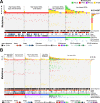Racial differences in endometrial cancer molecular portraits in The Cancer Genome Atlas
- PMID: 29682207
- PMCID: PMC5908308
- DOI: 10.18632/oncotarget.24907
Racial differences in endometrial cancer molecular portraits in The Cancer Genome Atlas
Abstract
Endometrial cancer (EC) is now the most prevalent gynaecological malignancy in the Western world. Black or African American women (BoAA) have double the mortality of Caucasian women, and their tumours tend to be of higher grade. Despite these disparities, little is known regarding the mutational landscape of EC between races. Hence, we wished to investigate the molecular features of ECs within The Cancer Genome Atlas (TCGA) dataset by racial groupings. In total 374 Caucasian, 109 BoAA and 20 Asian patients were included in the analysis. Asian women were diagnosed at younger age, 54.2 years versus 64.5 years for Caucasian and 64.9 years for BoAA women (OR 3.432; p=0.011); BoAA women were more likely to have serous type tumors (OR 2.061; p=0.008). No difference in overall survival was evident. The most frequently mutated gene in Caucasian and Asian tumours was PTEN (63% and 85%), unlike BoAA cases where it was TP53 (49%). Mutation and somatic copy number alteration (SCNA) analysis revealed an enrichment of TP53 mutations in BoAAs; whereas POLE and RPL22 mutations were more frequent in Caucasians. Major recurrent SCNA racial differences were observed at chromosomes 3p, 8, 10, and 16, which clustered BoAA tumors into 4 distinct groups and Caucasian tumors into 5 groups. There was a significantly higher frequency of somatic mutations in DNA mismatch repair genes in Asian tumours, in particular PMS2 (p=0.0036). In conclusion, inherent racial disparities appear to be present in the molecular profile of EC, which could have potential implications on clinical management.
Keywords: TCGA; endometrial cancer; ethnicity; somatic copy number aberrations.
Conflict of interest statement
CONFLICTS OF INTEREST The authors declare no conflicts of interest.
Figures




Similar articles
-
TP53 Mutational Spectrum in Endometrioid and Serous Endometrial Cancers.Int J Gynecol Pathol. 2016 Jul;35(4):289-300. doi: 10.1097/PGP.0000000000000243. Int J Gynecol Pathol. 2016. PMID: 26556035 Free PMC article.
-
Mutational analysis of the tyrosine kinome in serous and clear cell endometrial cancer uncovers rare somatic mutations in TNK2 and DDR1.BMC Cancer. 2014 Nov 26;14:884. doi: 10.1186/1471-2407-14-884. BMC Cancer. 2014. PMID: 25427824 Free PMC article.
-
Mutation spectrum of POLE and POLD1 mutations in South East Asian women presenting with grade 3 endometrioid endometrial carcinomas.Gynecol Oncol. 2016 Apr;141(1):113-20. doi: 10.1016/j.ygyno.2015.12.031. Epub 2015 Dec 31. Gynecol Oncol. 2016. PMID: 26748215
-
The emerging role of molecular pathology in directing the systemic treatment of endometrial cancer.Ther Adv Med Oncol. 2021 Aug 14;13:17588359211035959. doi: 10.1177/17588359211035959. eCollection 2021. Ther Adv Med Oncol. 2021. PMID: 34408794 Free PMC article. Review.
-
Genomics and splicing events of type II endometrial cancers in the black population: racial disparity, socioeconomic and geographical differences.Am J Cancer Res. 2020 Oct 1;10(10):3061-3082. eCollection 2020. Am J Cancer Res. 2020. PMID: 33163258 Free PMC article. Review.
Cited by
-
Distribution differences in prognostic copy number alteration profiles in IDH-wild-type glioblastoma cause survival discrepancies across cohorts.Acta Neuropathol Commun. 2019 Jun 18;7(1):99. doi: 10.1186/s40478-019-0749-8. Acta Neuropathol Commun. 2019. PMID: 31215469 Free PMC article.
-
Disease progression, survival, and molecular disparities in Black and White patients with endometrioid endometrial carcinoma in real-world registries and GOG/NRG oncology randomized phase III clinical trials.Gynecol Oncol. 2024 Apr;183:103-114. doi: 10.1016/j.ygyno.2024.03.026. Epub 2024 Apr 8. Gynecol Oncol. 2024. PMID: 38593674 Free PMC article.
-
Histopathologic, Genetic and Molecular Characterization of Endometrial Cancer Racial Disparity.Cancers (Basel). 2021 Apr 15;13(8):1900. doi: 10.3390/cancers13081900. Cancers (Basel). 2021. PMID: 33920951 Free PMC article. Review.
-
Endometrial cancer among a cohort of urban Haitian immigrants.World J Clin Oncol. 2019 Oct 24;10(10):340-349. doi: 10.5306/wjco.v10.i10.340. World J Clin Oncol. 2019. PMID: 31799149 Free PMC article.
-
Role of Precision Oncology in Type II Endometrial and Prostate Cancers in the African Population: Global Cancer Genomics Disparities.Int J Mol Sci. 2022 Jan 6;23(2):628. doi: 10.3390/ijms23020628. Int J Mol Sci. 2022. PMID: 35054814 Free PMC article. Review.
References
-
- Cote ML, Ruterbusch JJ, Olson SH, Lu K, Ali-Fehmi R. The growing burden of endometrial cancer: a major racial disparity affecting black women. Cancer Epidemiol Biomarkers Prev. 2015;24:1407–1415. - PubMed
-
- Jamison PM, Noone AM, Ries LA, Lee NC, Edwards BK. Trends in endometrial cancer incidence by race and histology with a correction for the prevalence of hysterectomy, SEER 1992 to 2008. Cancer Epidemiol Biomarkers Prev. 2013;22:233–241. - PubMed
-
- Setiawan VW, Pike MC, Kolonel LN, Nomura AM, Goodman MT, Henderson BE. Racial/ethnic differences in endometrial cancer risk: the multiethnic cohort study. Am J Epidemiol. 2007;165:262–270. - PubMed
LinkOut - more resources
Full Text Sources
Other Literature Sources
Research Materials
Miscellaneous

